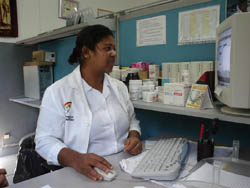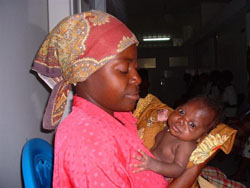The Experience of DREAM in Mozambique

It may be useful to analyse at least one concrete experience of the programme, better still, the first experience, the first time DREAM effectively took root in the system of a country, Mozambique. The example is especially relevant, because this initial programme would set a standard. Many intuitions and questions that were the starting points of the team setting up DREAM became effective practices and responses, serving as the basis for a model for later services within country systems.
The choice to start with Mozambique arose from a long history linking the Community of Sant’Egidio to that Southern African country, a history that spans the dispatch of humanitarian aid at the start of the eighties, to official mediation between the rebels and government that led to the signing of the General Peace Agreement in Rome on 4 October 1992, to the birth of local communities, large and small, of Sant’Egidio in many Mozambican cities. It was precisely this special link with Mozambique that led the Community to choose that country to launch the DREAM programme.
It was in January 2002 that our first Mozambican molecular biology laboratory started to function. Ten years after the Rome peace accord, the challenge at hand was to end a new war, a war that claimed even more victims: the war on HIV. And the beginning was by no means easy. In the first weeks, only a handful of sick people came to the health centre hosting DREAM in Maputo. Only those people who had nothing left to lose, the most desperate ones, came for testing, those who clearly had AIDS and who were thus rejected by everyone else.
Within two to three months, however, the same sick people underwent a transformation. They had spectacular results, and true “resurrections” were witnessed. Abandoned women, lying on mats in their huts, already resigned to their fate, increased their weight from 30 to 70kg and started to take care of their many children again. Very ill men – unable to walk any longer, prostrated not only by sickness, but by the humiliation that they could no longer do anything for their families – got up and started to work again, recovering their dignity.
As these results became common knowledge, prejudice and fear were defeated and hope was reborn. In the two years since the first 50 tests were done, more than 20,000 tests have been carried out in Mozambique alone.
In May 2002, also in Mozambique, the Community of Sant’Egidio started its own prevention activities targeting HIV-positive, pregnant women. The aim of DREAM, however, was not only to ensure the birth of children free of the HIV virus, thus fighting the vertical transmission of AIDS, but also to keep them healthy in the long term. This would be achieved thanks to artificial feeding and especially thanks to the fact that the health of their mothers would be protected and saved. In Africa, an orphan, even if he/she does not have AIDS, is doomed to live a very short life. It is the mother’s survival that makes the difference.

The therapeutic approach chosen by DREAM was characterised by the introduction of tri-therapy for pregnant women and continuation of treatment even after delivery, if they needed it. To date, 1,500 children have been born within the mother-child prevention programme of DREAM, 99% of them without AIDS, a percentage rate equal to that observed in the West, further proof that African women care about their children’s health just as western mothers do.
We could cite many examples of how DREAM treatment has changed the lives of many Mozambicans, most of all by prolonging those lives. But perhaps the most significant example is the involvement of sick people themselves in the spreading of the programme.
When they started to feel better, a group of sick women (and also of sick men) set up an association, ‘Mulheres para o dream,’ ‘Women for a dream.’ Many of these women work for the programme, welcoming those who come for the first time, encouraging, helping them to follow treatment and to look after their children. Above all, they bear witness, through their lives, that AIDS is not a death sentence. This represents a very important aspect of the programme, because the association becomes a fundamental means of reinsertion into life: people move away from exclusion and stigma, they start going out of the house once again, working and finding meaning in helping others, becoming vehicles of cultural transmission.
After a long period of training, DREAM activists undertake peer education work of inestimable value that goes far beyond simple notions about the HIV virus, amounting to an investment in many other aspects of life: Nutrition, personal and domestic hygiene, the prevention of infectious pathologies, and much more. Thus, from being the main victims of AIDS, women undergo a transition to become protagonists in liberation from the disease. Involving the women as activists means making use of a human resource that translates into wealth for the country.
Adapted with permission from the DREAM website, February 2009.

- Comunità di Sant'Egidio
- Piazza S.Egidio 3a - 00153 - Roma, Italia
- Programma DREAM
- TEL: +39 06 8992225
- FAX: +39 06 89922525
- E-mail: dream@santegideo.org
- Website:dream.santegidio.org
- Website:www.santegidio.org